Filter News
Area of Research
- (-) Biological Systems (16)
- (-) Fossil Energy (3)
- (-) Nuclear Systems Modeling, Simulation and Validation (3)
- Advanced Manufacturing (28)
- Biology and Environment (72)
- Biology and Soft Matter (1)
- Building Technologies (10)
- Chemical and Engineering Materials (1)
- Chemistry and Physics at Interfaces (4)
- Clean Energy (319)
- Climate and Environmental Systems (6)
- Computational Biology (5)
- Computational Engineering (4)
- Computer Science (14)
- Electricity and Smart Grid (1)
- Energy Frontier Research Centers (7)
- Energy Sciences (4)
- Fuel Cycle Science and Technology (1)
- Functional Materials for Energy (6)
- Fusion and Fission (21)
- Fusion Energy (10)
- Geographic Information Science and Technology (2)
- Isotope Development and Production (2)
- Isotopes (13)
- Materials (279)
- Materials Characterization (2)
- Materials for Computing (23)
- Materials Synthesis from Atoms to Systems (5)
- Materials Under Extremes (5)
- Mathematics (1)
- National Security (32)
- Neutron Data Analysis and Visualization (2)
- Neutron Science (112)
- Nuclear Science and Technology (42)
- Nuclear Systems Technology (1)
- Quantum Condensed Matter (1)
- Quantum information Science (4)
- Reactor Technology (1)
- Renewable Energy (2)
- Sensors and Controls (3)
- Supercomputing (148)
- Transportation Systems (7)
News Topics
Media Contacts

Oak Ridge National Laboratory scientists identified a gene “hotspot” in the poplar tree that triggers dramatically increased root growth. The discovery supports development of better bioenergy crops and other plants that can thrive in difficult conditions while storing more carbon belowground.

Researchers at Oak Ridge National Laboratory are developing a first-of-a-kind toolkit drawing on video game development software to visualize radiation data.

Nuclear scientists at Oak Ridge National Laboratory have established a Nuclear Quality Assurance-1 program for a software product designed to simulate today’s commercial nuclear reactors – removing a significant barrier for industry adoption of the technology.


For decades, biologists have believed a key enzyme in plants had one function—produce amino acids, which are vital to plant survival and also essential to human diets. But for Wellington Muchero, Meng Xie and their colleagues, this enzyme does more than advertised. They had run a series of experiments on poplar plants that consistently revealed mutations in a structure of the life-sustaining enzyme that was not previously known to exist.



Researchers at the Department of Energy’s Oak Ridge National Laboratory (ORNL) have released the largest-ever single nucleotide polymorphism (SNP) dataset of genetic variations in poplar trees, information useful to plant scientists






